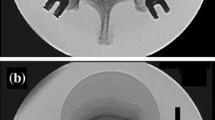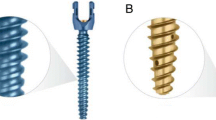Abstract
Introduction
Failure of pedicle screws by loosening and back out remains a significant clinical problem. Pedicle screw fixation is determined by bone mineral density, pedicle morphology and screw design. The objective of this study was to compare the holding strength of newly developed dual core pedicle screws having a cylindrical design in terms of outer diameter and two cylindrical inner core regions connected by a conical transition with conventional cylindrical pedicle screws.
Materials and methods
Fifty bovine lumbar vertebrae and 40 human lumbar vertebrae were used. Five different screws were tested in nine experimental “settings” and ten specimens each. The screws were tested for cranial displacement and pullout strength before and after 5,000 cycles of cranio-caudal loading. The tests included a setting with fully inserted and 4 mm backed out screws. For statistical analysis the incomplete balanced block design was used.
Results
Cyclic loading led to a decrease of pullout force between 24 and 31% and a 9% increase of displacement. The cylindrical screw designs were affected more than the dual core designs. The pullout force of cylindrical screws was smaller than of dual core screws. Even in a backed out condition dual core screws showed a significantly smaller displacement than cylindrical screws.
Conclusion
Pedicle screws with the dual core design provide good anchorage in the vertebra.




Similar content being viewed by others
References
Abshire BB, McLain RF, Valdevit A, Kambic HE (2001) Characteristics of pullout failure in conical and cylindrical pedicle screws after full insertion and back-out. Spine J 1:408–414
Bergot C, Laval-Jeantet AM, Hutchinson K, Dautraix I, Caulin F, Genant HK (2001) A comparison of spinal quantitative computed tomography with dual energy X-ray absorptiometry in European women with vertebral and non vertebral fractures. Calcif Tissue Int 68:74–82
Brantley AG, Mayfield JK, Koeneman JD, Clark KR (1994) The effects of pedicle screw fit. An in vitro study. Spine 19:1752–1758
Chapman JR, Harrington RM, Lee KM (1996) Factors affecting the pullout strength of cancellous bone screws. J Biomech Eng 118:391–398
Cook SD, Salkfeld SL, Stanley T, Faciane A, Miller SD (2004) Biomechanical study of pedicle screw fixation in severely osteoporotic bone. Spine J 4:402–408
Daftari TK, Horton WC, Hutton WC (1994) Correlations between screw hole preparation, torque of insertion, and pullout strength for spinal screws. J Spinal Disord 7:139–145
DeCoster TA, Heetderks DB, Downey DJ, Ferries JS, Jones W (1990) Optimizing bone screw pullout force. J Orthop Trauma 4:169–174
Di Lorenzo N, Conti R, Romoli S (2000) Retrieval of broken pedicle screws by “friction” technique. Technical note. J Neurosurg 92:114–116
Hirano T, Hasegawa K, Takahashi HE (1997) Structural characteristics of the pedicle and its role in screw stability. Spine 22:2504–2509
Inceoglu S, Ferrara L, McLain RF (2004) Pedicle screw fixation strength: pullout versus insertional torque. Spine J 4:513–518
Kwok AW, Finkelstein JA, Woodside T, Hearn TC, Hu RW (1996) Insertional torque and pull-out strengths of conical and cylindrical pedicle screws in cadaveric bone. Spine 21:2429–2434
Lapresle P, Missenard G (1995) Hydroxylapatite-coated Diapason screws: first clinical report. J Spinal Disord 8(Suppl. 1):31–39
Lei W, Wu ZX (2005) Biomechanical evaluation of an expansive pedicle screw in calf vertebrae. Chin J Traumatol 8:39–45
Lill CA, Schlegel U, Wahl D, Schneider E (2000) Comparison of the in vitro holding strengths of conical and cylindrical pedicle screws in a fully inserted setting and backed out 180 degrees. J Spinal Disord 13:259–266
Lonstein JE, Denis F, Perra JH, Pinto MR, Smith MD, Winter RB (1999) Complications associated with pedicle screws. J Bone Joint Surg Am 81:1519–1528
McLain RF, Fry MF, Moseley TA, Sharkey NA (1995) Lumbar pedicle screw salvage: pullout testing of three different pedicle screw designs. J Spinal Disord 8:62–68
Misenhimer GR, Peek RD, Wiltse LL, Rothman SL, Widell EHJ (1989) Anatomic analysis of pedicle cortical and cancellous diameter as related to screw size. Spine 14:367–372
Mummanemi PV, Haddock SM, Liebschner MA, Keaveny TM, Rosenberg WS (2002) Biomechanical evaluation of a double-threaded pedicle screw in elderly vertebrae. J Spinal Disord Tech 15:64–68
Musha Y, Okajima Y, Motegi M (1995) Lumbar spinal fusion using the Diapason system. J Spinal Disord 8(Suppl. 1):7–14
Renner SM, Lim TH, Kim WJ (2004) Augmentation of pedicle screw fixation strength using injectable calcium phosphate cement as a function of injection timing and method. Spine 29:E212–E216
Scifert JL, Sairyo K, Goel VK, Grobler LJ, Grosland NM, Spratt KF, Chesmel KD (1999) Stability analysis of an enhanced load sharing posterior fixation device and its equivalent conventional device in a calf spine model. Spine 24:2206–2213
Searle SR, Speed FM, Milliken GA (1980) Population marginal means in the linear model: an alternative to the least squares means. Am Stat 34:216–221
Seebeck J, Goldhahn J, Städele H, Messmer P, Morlock MM, Schneider E (2004) Effect of cortical thickness and cancellous bone density on the holding strength of internal fixator screws. J Orthop Res 22:1237–1242
Shimamoto N, Kotani Y, Shono Y (2002) Biomechanical evaluation of anterior spinal instrumentation systems for scoliosis: in vitro fatigue simulation. Spine 26:2701–2708
Skinner R, Maybee J, Transfeldt E, Venter R, Chalmers W (1990) Experimental pullout testing and comparison of variables in transpedicular screw fixation. A biomechanical study. Spine 15:195–201
Stambough JL, El Khatib F, Genaidy AM, Huston RL (1999) Strength and fatigue resistance of thoracolumbar spine implants: an experimental study of selected clinical devices. J Spinal Disord 12:410–414
Swartz DE, Wittenberg RH, Shea M, White AA, Hayes WC (1991) Physical and mechanical properties of calf lumbosacral trabecular bone. J Biomech 24:1059–1068
Wittenberg RH, Lee KS, Shea M, White AA, Hayes WC (1993) Effect of screw diameter, insertion technique, and bone cement augmentation of pedicular screw fixation strength. Clin Orthop Relat Res 296:278–287
Youssef JA, McKinley TO, Yerby SA, McLain RF (1999) Characteristics of pedicle screw loading. Effect of sagittal insertion angle on intrapedicular bending moments. Spine 24:1077–1081
Zindrick MR, Wiltse LL, Widell EH (1986) A biomechanical study of intrapeduncular screw fixation in the lumbosacral spine. Clin Orthop Relat Res 203:99–112
Acknowledgments
The authors thank Prof D. Sasse (Institute of Anatomy, University of Basel) for providing the human spine specimens, Stratec Medical, Oberdorf, for providing the pedicle screws, D. Wahl for assistance during testing and D. Pfluger for performing the statistical analysis. The experiments comply with the current laws of Switzerland.
Author information
Authors and Affiliations
Corresponding author
Rights and permissions
About this article
Cite this article
Lill, C.A., Schneider, E., Goldhahn, J. et al. Mechanical performance of cylindrical and dual core pedicle screws in calf and human vertebrae. Arch Orthop Trauma Surg 126, 686–694 (2006). https://doi.org/10.1007/s00402-006-0186-6
Received:
Published:
Issue Date:
DOI: https://doi.org/10.1007/s00402-006-0186-6




